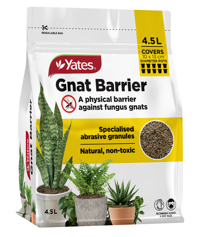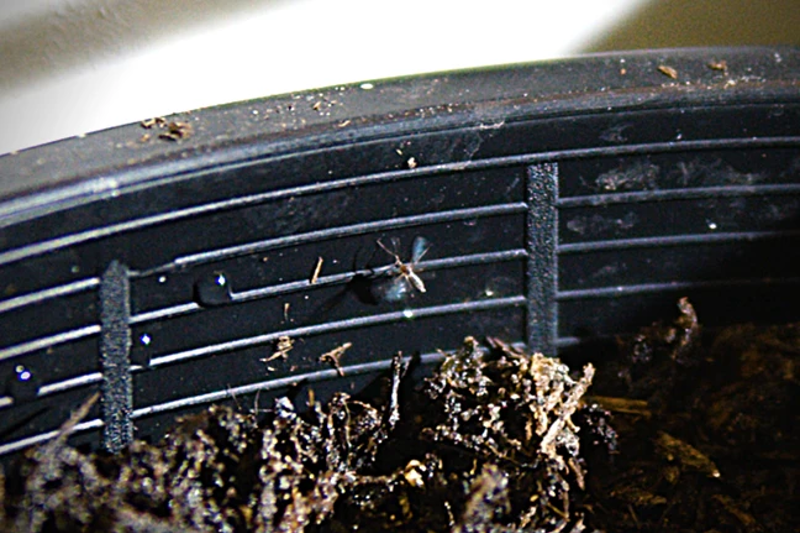Yates Account
Join now
Create a Yates account today!
Sign up to join the Yates Garden Club for monthly e-mails packed with seasonal inspiration, tips for success & exclusive promotions.
Plus if you’re a Garden Club member you can take part in the Yates Growing Community - a blog to share successes, get advice & win prizes in fun challenges along the way!

Forgot password
Enter the email address associated with your account, and we'll email you a new password.
Diptera

Fungus Gnat Control in Your Garden
Have you ever wondered what those irritating mosquito-like flies are hovering around your indoor plants? They're almost certainly Fungus Gnats. There are several families of flies referred to as ‘fungus gnats’, but the ones you're likely to encounter at home are Dark Winged Fungus Gnats (Bradysia spp.) from the Sciaridae family.
Fungus gnats are serious pests in commercial greenhouses and plant nurseries, where they're attracted to potting media, especially media with a high content of moisture and organic matter. Adult fungus gnats are simply an annoyance, it's their larvae that cause the real problems. Fungus gnat larvae feed on plant roots and can cause damage to seedling stems.
Intriguingly, our beloved native glowworms (Arachnocampa luminosa) are also a species of fungus gnat, but you won't see them outside their preferred humid, deeply shaded habitats.


How do I Get Rid of Them?
The best way to protect your indoor plants is to prevent adult fungus gnats laying eggs in the potting media. Try Yates Gnat Barrier to help control them in your indoor plants. Yates Gnat Barrier is a natural, non-chemical, physical barrier made from abrasive pumice granules.
The secret to pest control is to keep a close eye on your plants, so you can spot pest incursions early. For example, you could scan (see Monitor) while you are watering your plants – check for fungus gnats flying around your plants, or walking on the potting media surface. For this to work you will need to know what fungus gnats look like (see Description), so that you know they are actually fungus gnats and not something else.
Prevention is always better than cure. As well as trying Yates Gnat Barrier, there are a couple of other things that you can do to prevent incursions from fungus gnats (see How to Prevent Fungus Gnats Appearing).
Regular monitoring of your house plants will ensure that a major infestation of fungus gnats doesn’t occur ‘overnight’. Managing gnats is much easier if you can catch an infestation in its early stages.

What are Fungus Gnats?
Fungus gnats are tiny insects that are part of the fly order Diptera, that resemble mosquitos in appearance. They can be a real annoyance in the home. Major infestations can result in damage to seedlings in greenhouses.
Description
Common fungus gnat adults are small, dark mosquito-like flies about 4mm long, with small heads and long legs. You might see them running on the soil surface. They are weak fliers, so they tend to just hover around house plants. They have a single pair of wings with a distinctive Y-shaped vein at the tips.
Eggs are tiny (0.2mm), oval, translucent white and laid in crevices in the soil surface.
Larvae are pale, translucent, legless maggots, which grow to about 5-7mm long, with shiny black heads. They're usually found in the top 25-50mm of potting media.
Pupae are brown, about 3mm long, and found just under the soil surface.

Life Cycle
Female fungus gnats can lay around 100-200 eggs over their one week life span. Eggs are laid in the soil, and the larvae hatch and grow over a period of two weeks. Pupation occurs in a silken chamber near the soil surface. Adult flies emerge from the pupae about five days later. The entire life-cycle takes about four weeks.
Plants Impacted by Fungus Gnats
Fungus gnats are pests of:
- House plants
- Potted plants in greenhouses and sheltered outdoor areas

Symptoms of Fungus Gnats
- Fungus gnats are usually only a ‘nuisance’ in the home if the infestation is minor.
- Fungus gnat larvae usually only feed on organic matter in the potting media of house plants when the infestation is minor, but large populations of fungus gnat larvae can cause damage to the roots of house plants. In extreme cases, plant growth may be stunted.
- Larvae may tunnel into the stems of seedlings at or below the soil level causing the seedlings to collapse.
- Fungus gnat larvae can transmit soil-borne fungal diseases such as Pythium and Fusarium, which may result in ‘Damping Off’ of seedlings.

How to Prevent Fungus Gnats Appearing
Monitor
- Watch for small mosquito-like insects hovering near houseplants.
- If you see a few adult fungus gnats hovering around your house plants, check the top 25mm of potting media for larvae.
- An easy method to check for fungus gnat larvae is to place a 10mm slice of potato on the surface of the growing media, of each pot. fungus gnat larvae will migrate up to the potato slices to feed after a day or two. Turn over the potato slices, to check for larvae on the underside.
- Seedlings in greenhouses are susceptible to stem damage from fungus gnats. Watch for seedlings that lack vigour, or have leaves turning yellow. if symptoms occur, check your seedling mix for fungus gnat larvae.
- Check that your house plants and other pots, and seedling trays aren’t overwatered.
Prevent
- Try Yates Gnat Barrier.
- Fungus gnat larvae prefer feeding in very moist soil. If fungus gnats are a frequent problem at your place, allow the top 25-50mm of potting media to dry out before watering again.
- Don’t allow pots to sit in trays full of water.
- Always use clean, sterile potting mix. If reusing potting mix, you may need to sterilise it.
- Potting mixes containing high levels of peat are known to be attractive to fungus gnat adults. Purchase potting media with low levels of peat, or if mixing your own, try leaving peat out of the mix.













Share
Share this article on social media